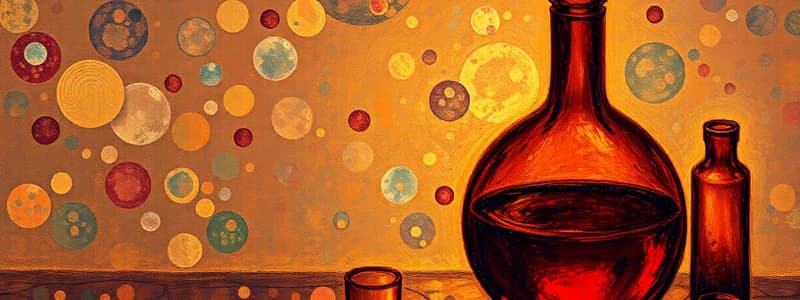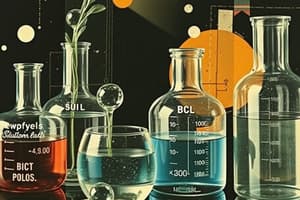Podcast
Questions and Answers
What is the size range of colloid particles?
What is the size range of colloid particles?
- > 1000 nm
- 0.1 nm to 10 nm
- 1 nm to 1000 nm (correct)
- 100 nm to 1000 nm
Colloids are made up of particles that can easily settle like larger suspensions.
Colloids are made up of particles that can easily settle like larger suspensions.
False (B)
What term describes a dispersion of particles of one substance throughout another substance?
What term describes a dispersion of particles of one substance throughout another substance?
Colloid
The diameter of particles in a suspension is greater than _____ nm.
The diameter of particles in a suspension is greater than _____ nm.
Match the following types of systems with their corresponding diameter ranges:
Match the following types of systems with their corresponding diameter ranges:
Flashcards
Colloid
Colloid
A dispersion of particles of one substance throughout another medium.
Size of Colloid
Size of Colloid
Colloid particles range from 1 nm to 1000 nm in diameter.
Suspension
Suspension
A mixture with particles larger than 1000 nm that tend to settle.
True Solution
True Solution
Signup and view all the flashcards
Lyophilic Colloid
Lyophilic Colloid
Signup and view all the flashcards
Study Notes
Colloids
- Colloids are dispersions of one substance throughout another
- The dispersed substance is called the dispersed phase
- The substance doing the dispersing is called the dispersion medium
- Colloid particle size is between coarse suspension and true solution (1 nm to 1000 nm)
Types of Colloids
- Solid sols: Alloy, rubber, plastic
- Sols: Paint, starch, iron(III) hydroxide
- Aerosols: Smoke, dust, smog
- Solid Emulsions: Cheese, butter, jelly
- Emulsions: Mayonnaise, lotion, milk
- Liquid Aerosols: Fog, clouds, aerosols
- Solid Foams: Sponge, Styrofoam
- Foams: Whipped cream, shaving cream
Properties of Solutions, Colloids, and Suspensions
| Property | Solutions | Colloids | Suspensions |
|---|---|---|---|
| Settling | No | No | Yes |
| Filtration | No | No | Yes |
| Membrane | No | No | Yes |
| Light Scattering | No | Yes | Yes |
| Colligative Properties | Yes | No | No |
Differences Between True Solutions and Colloidal Systems
- In a true solution, particles (atoms, ions, or molecules) are very small (<1 nm)
- In a colloidal system, particles are larger (1-1000 nm)
Examples of Colloids
- Macromolecular colloids: Protein, carbohydrates, plastic
- Clusters of molecules: Sulfur, soap, tiny crystals (silver chloride, gold)
Applications of Colloids
- Pharmaceutical industry (medicines like cod liver oil)
- Paint industry
- Detergents
- Dyes
- Advanced inks
- Pharmaceutical products
- Inorganic additives
- Organic pigments
- Polymers
Emulsions
- Emulsions are colloidal solutions where both the dispersed phase and dispersion medium are liquids
- Classified into Oil-in-water (O/W) and Water-in-oil (W/O) emulsions.
- Oil-in-water (O/W): Oil is dispersed in water
- Examples: Milk, vanishing cream
- Water-in-oil (W/O): Water is dispersed in oil
- Examples: Butter, cold cream, cod liver oil
Emulsifiers
- Lipids are nonpolar and do not dissolve in water
- Emulsifiers are molecules with both polar and nonpolar parts, allowing them to dissolve in both lipids and water
- Emulsifiers suspend lipid droplets in water, preventing them from separating
Classification of Sols
- Lyophilic Sols (Solvent-loving): Strong attraction between dispersed phase and dispersion medium (water)
- Examples: Starch, milk, albumin, blood plasma, gel, glue
- Lyophobic Sols (Solvent-hating): Little or no attraction between dispersed phase and dispersion medium (water)
- Examples: Sulfur, gold, iron(III) hydroxide, aluminum hydroxide
Properties of Lyophilic Sols
- Reversible
- High viscosity of the dispersion medium
- Dispersed phase particles can attract molecules of the dispersion medium (e.g. water)
- Lower surface tension compared to lyophobic sols
- Require a large amount of electrolyte to coagulate
Properties of Lyophobic Sols
- Irreversible
- Little or no attraction between dispersed phase and the dispersion medium
- Viscosity similar to the dispersion medium
- Similar surface tension as the dispersion medium
- Less stable (require less electrolytes to coagulate)
Preparation of Lyophilic Sols
- Typically formed by spontaneous mixing; easily prepared
- Stirring the solid with the dispersing medium (water)
- Heating the mixture to disperse the solid throughout the medium
Preparation of Lyophobic Sols
- Difficult to prepare as there's little or no attraction between the dispersed phase and the dispersion medium.
- Several methods:
- Dispersion Methods: Reduce larger particles to colloidal size by: Mechanical dispersion, Peptization, Bredig's arc method
- Condensation Methods: Formation of colloidal particles from smaller units: hydrolysis, oxidation, reduction
Bredig's Arc Method
- Preparing metal sols by striking an electric arc between metal electrodes immersed in a dispersion medium
Peptization
- Method to convert a freshly prepared precipitate into a colloidal sol using an electrolyte (peptizing agent)
- The electrolyte's ions adsorb onto the precipitate's surface, leading to charge development and dispersion
Purification of Colloidal Sols
- Common impurities are electrolytes
- Purification methods: Dialysis, ultrafiltration, ultracentrifugation
Dialysis
- Removal of soluble impurities from sols using a semi-permeable membrane
- The membrane allows small molecules (solutes) to pass through but not large colloidal particles
Tyndall Effect
- Scattering of light by colloidal particles, making their path visible
Brownian Movement
- Random movement of colloidal particles in a dispersion medium due to bombardment by smaller molecules or atoms in the dispersion medium
Electrical Properties of Colloids
- Electrophoresis: Movement of charged colloidal particles in an electric field towards the oppositely charged electrode
- Electro-osmosis: Movement of the dispersion medium across a membrane when electric current applied
Coagulation (Flocculation)
- Process where a colloid precipitates out of a solution
- Lyophilic sols are more stable to coagulation than lyophobic sols.
- Large amounts of electrolytes are required to coagulate lyophilic sols due to strong attractions between the phase and the dispersion medium.
- Lyophobic sols are stabilized by similarly charged particles; coagulation occurs when the charge is removed (add opposite charges)
- Common coagulants include alum.
Effect of Cation/Anion on Coagulation
- Stronger precipitating effect with higher valency of the cation or anion (Hardy-Schulze rule)
Coagulation Methods in Water Treatment
- Removing solids by sedimentation and filtration after coagulation with alum or other chemicals.
- The methods involve adding a positive charge to water particles to allow clumping into large particles for sedimentation and removal.
Alum
- Often used as a coagulant, it's aluminum sulfate, available as liquid or dry forms
Coagulation of Negatively Charged Colloids
- Coagulation using electrolytes with positive charges is more effective
- The specific coagulation values depend on the electrolyte and the valency of the cation.
Coagulation of Positively Charged Colloids
- Coagulation using electrolytes with negative charges is more effective
- The specific coagulation values depend on the electrolyte and the valency of the anion.
Exercise 1
- i) Two properties of lyophilic sols: Reversible, high viscosity
- ii) Colloid purification: Removal of impurities (electrolytes) using methods like dialysis, ultrafiltration, ultracentrifugation
- iii) Brownian movement: Random movement of colloidal particles due to collisions with surrounding molecules
- iv) Sol vs. Emulsion: Sols are solid particles dispersed in a liquid; emulsions are liquid particles dispersed in a liquid (e.g. oil droplets in water).
Exercise 2
- i) Cheese: Dispersion medium=water, Dispersed phase=solid fat particles
- ii) Paint: Dispersion medium= solvent, Dispersed phase= solid pigment
- iii) Fog: Dispersion medium= air, Dispersed phase= water droplets
Exercise 3
- Explain the dispersion methods for preparing lyophobic sols (mechanical dispersion, Bredig arc method, peptization, hydrolysis)
Studying That Suits You
Use AI to generate personalized quizzes and flashcards to suit your learning preferences.




